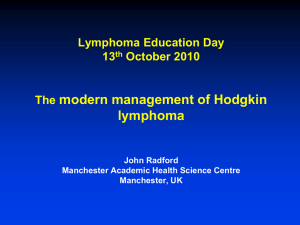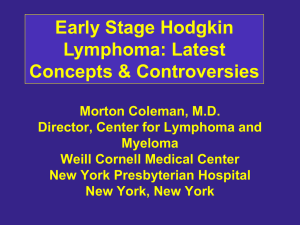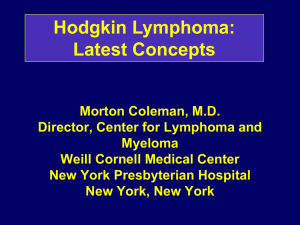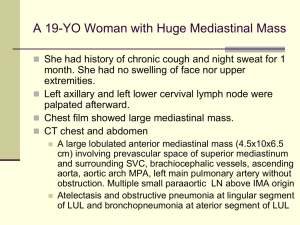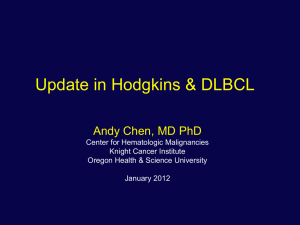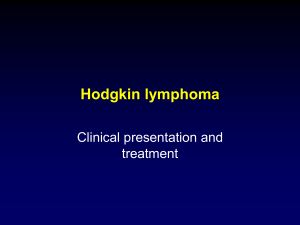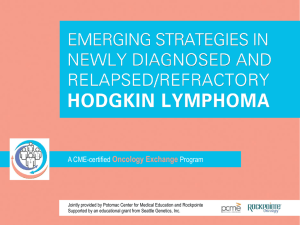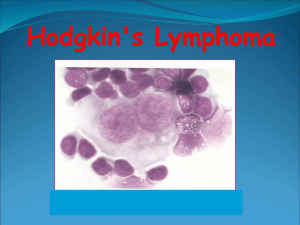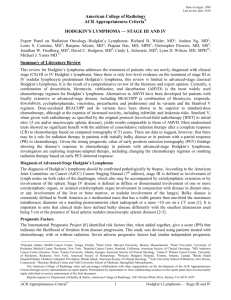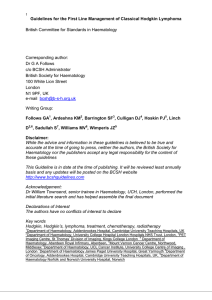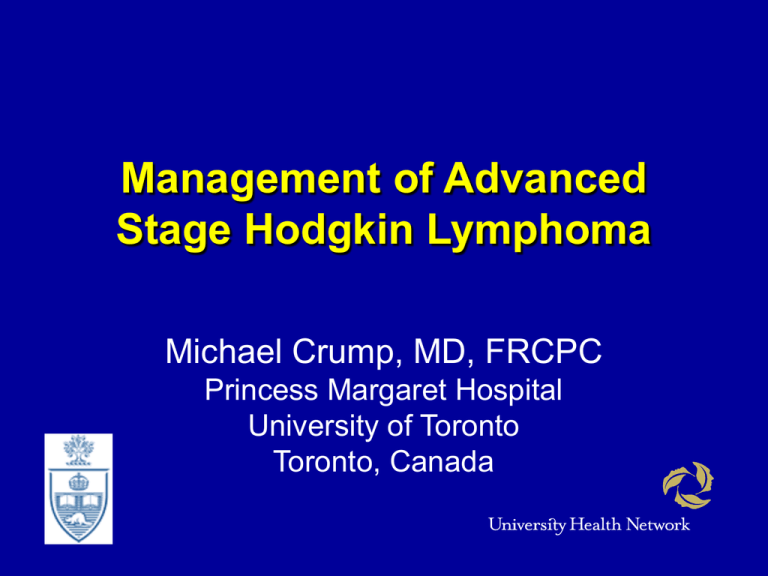
Management of Advanced
Stage Hodgkin Lymphoma
Michael Crump, MD, FRCPC
Princess Margaret Hospital
University of Toronto
Toronto, Canada
Outline of this presentation
• Definition and incidence
• Historical results and the need for
change
• Recent trials of new approaches
• Nodular lymphocyte predominant HL
• Late effects in advanced stage HL
• Conclusions
Decline in mortality rate from HL in North America
MOPP
ABVD
Aisenberg, Blood, 1999; Reprinted from Ries; NIH Publ 97-2789, 1997
HL Outcomes – Continued Improvement
Brenner, et al. Blood, 2008
US SEER database:
all
Relative survival:
>16,000 pts 1980-2004
25-34y
>60y
5y
1980-84
73%
2000-04
85%
10 y
62%
80%
Advanced HL: definitions
• NA intergroup: stage III, IV; relapse
after prior extended field radiotherapy
• British: B symptoms (any stage); II with
bulky mediastinal mass; stage III, IV
• German Hodgkin Study Group:
– Stage IIB + E extension or LMM; III, IV
– Early, unfavourable: stage I,II with E
lesions, LMM, ↑ ESR, > 3 sites
Prognostic factors in advanced HL
• Hasenclever-Diehl index NEJM 1998
• >5000 patients (13% stage I-IIB)
– Complete data for model: ~1600
• 7 clinical variables:
–
–
–
–
–
–
–
Age > 45 y
Male sex
Hb <105g/L
Stage IV
Albumen < 40 g/L
WBC > 15
Lymphocytes <0.6 or <8%
Biologic prognostic factors?
• Epstein-Barr Virus (EBV)
~25-35% +ve by IHC (LMP-1), ISH (EBER-1)
More common: males, older age (>45),
mixed cellularity histology
Older adults → less favourable outcome
•
•
•
•
BCL-2
Cytokine levels
Cytokine gene polymorphisms
Tumour microenvironment
etc…
Previous Therapeutic Observations in
Advanced Disease
• ABVD is superior to MOPP, and equal to but
less toxic than alternating MOPP-ABVD
– Canellos G, et al, NEJM, 1992, 2002
• ABVD is equivalent to alternating and hybrid
multidrug regimens, with less toxicity
– Johnson PW, et al, JCO 2005
Recent Therapeutic Observations in
Advanced Stage Disease
ABVD is equivalent to MOPP/ABV but has
less serious/fatal toxicity
– Duggan D et al; JCO 2006
Esc BEACOPP is superior to COPP-ABVD
– Diehl V, et al: NEJM, 2003
Advanced Hodgkin Lymphoma
ABVD vs MOPP/ABV Hybrid
Intergroup CALGB, ECOG, SWOG, NCIC
ABVD
n
MOPP/ABV
p
433
419
CR%
Progression %
76
10
80
11
0.16
5 y FFS%
5 y OS%
63
82
66
81
0.42
0.82
• Definition and incidence
• Historical results and the need for
change
• Recent trials of new approaches
• Nodular lymphocyte predominant HL
• Late effects in advanced stage HL
• Conclusions
New concepts evaluated in phase
II trials to improve results in HL
• Consolidation with high-dose therapy
and ASCT (high risk pts)
• Optimization of combined modality
therapy: Stanford V
• Intensification with non-cross-resistant
agents, increased dose intensity + GCSF
– escalated BEACOPP, other regimens
Not useful
• Intensification of COPP-ABV with IMEP
(ifos, MTX, etoposide, prednisone) vs C-A
GHSG HD6 trial
Ann Oncol 2004
• Intensification with ASCT in high risk HL
after CR/PR to ABVD/other x 4 cycles
Federico M, JCO 2003
Recent Randomized Trials of Novel Regimens
in Advanced Hodgkin Lymphoma
N pts CR(%) Progr’n (%) 5 y FFTF
Esc BEACOPP
BEACOPP
COPP-ABVD
ABVD
BEACOPP
COPP-EBV-CAD
ABVD
Stanford V
OS (yr)
466
469
260
96
88
85
2
8
10
87
76
69
91 (5)
88
83
99
98
98
70
81
69
12
2
10
65
78
71
84 (5)
92
91
261
259
67
57
5
6
85
73
90 (5)
92
CR: complete response rate; FFTF: freedom from treatment failure; OS: overall survival
BEACOPP Escalated
•
Bleomycin
•
Etoposide
•
Doxorubicin
•
Cyclophos
•
Vincristine
•
Procarbazine
•
Prednisone
Cycle length 21 days
mg/m2
day
10 IV
8
200 IV
1-3
35 IV
1
1200 IV
1
1.4 IV
8
100 PO 1-7
40 PO 1-14
G-CSF day 8-15
BEACOPP is superior to
COPP-ABVD
• Recent HD9 update: follow-up > 9 yrs
• 10 y FTFF and OS favour
escBEACOPP over BEACOPP, COPPABVD
Engert A, et al, J Clin Oncol 2009
GISL HD 2000
BEACOPP v ABVD v CEC
Federico M, J Clin Oncol 2009
Should escBEACOPP now be
the standard?
…maybe not yet
• Toxicity vs (COPP-)ABVD:
– Greater male, female infertility (vs ABVD:
fertility is unaffected)
– More significant Hb, plt toxicity;
fever/infection
– Higher secondary AML risk? (second
cancers: no difference)
– Elderly (age >60): more toxic, not more
effective
Other trials of this strategy
• GHSG HD12:
8 escBEACOPP vs 4 esc + 4 BEACOPP
Advanced disease, age <65
No difference in 5 y OS, FFTF
• EORTC-NCIC-GELA HD8:
4 esc + 4 BEACOPP vs 8 ABVD
--accrual recently completed
ABVD remains the standard for
advanced HL
Doxorubicin 25 mg/m2 d1, 15
Bleomycin 10 mg/m2 d1, 15
Vinblastine 6 mg/m2 d1, 15
Dacarbazine 375 mg/m2 d1, 15
ABVD remains the standard for
advanced HL
Practical points:
• Are pulmonary function tests required?
– Bleomycin lung toxicity: up to 30% of
patients; high case fatality rate (esp
elderly)
– No PFT at baseline, unless older or
underlying lung disease (smokers)
– In follow-up: if symptoms (cough, dyspnea,
fever) or if > 6 cycles ABVD planned
– Omission of bleo does not seem to
compromise treatment
ABVD remains the standard for
advanced HL
Practical points:
• Is G-CSF (neupogen) required?
– Not generally: several cohort studies of Rx
regardless of treatment-day ANC→ no
increase febrile neutropenia
– ? Association with bleomycin toxicity
– Should be used for pts at high risk of
febrile neutropenia: elderly, bone marrow
involvement, HIV+
– PMH recipe: daily x4-5, starting D5, A cycle
• (not needed with each treatment)
Hodgkin Lymphoma
Older Patients
HL age distribution (y)
Characteristic
age < 60
> 60
Stage
limited:advanced
1:2
2:1
Stage IV %
20
33
B symptoms %
25
33
Histology- NS:MC
3:1
1:1
Grade 3-4 tox. %
25
65
Fatal toxicity %
1-2
3 - 10
Advanced stage Hodgkin lymphoma
Data courtesy of
J Connors, BCCA
Age > 60
1.0
.8
.6
HYBRID 38
.4
ABVD
72
ODBEP 51
.2
MOPP
0.0
0
1
2
3
4
5
6
7
8
Progression Free Survival (y)
9
10
38
Advanced stage Hodgkin lymphoma
Age > 60
1.0
.8
Hybrid 38
.6
ABVD
72
.4
ODBEP 51
.2
MOPP 38
0.0
0
1
2
3
4
5
6
7
8
Disease Specific Survival (y)
9
10
Hodgkin Lymphoma
Older Patients
Chemotherapy recommendations
– No special regimen superior
• ABVD remains the gold standard
• If drugs must be omitted due to underlying organ dysfunction
– Consider 7 – 8 drug combinations, then drop offender(s)
– Anticipate increased toxicity
•
•
•
•
Hematologic
Neurologic
Pulmonary
Cardiac
– Enhance supportive care
• G-CSF
FDG PET?
Outcome of HL according to interim FDG PET and IPS
Gallamini A, J Clin Oncol 2007
RCT of Observation vs RT for Patients with
Bulky HL and Negative Post Chemo PET Scan
Bulk:
Chemo:
RT:
> 5 cm long axis*
VEBEP 6 cycles
32 Gy
Negative PET:
Positive PET:
no uptake
“uptake in …abnormal area”
260 patients
2000-2006
n = 160 randomized
stage I, II 2/3
B symptoms ½
Radiation:
mantle, inv Y, para-aortic
Picardi M, et al. Leuk Lymph, 2007
Relapse:
Chemo alone:
Chemo + RT:
11/80 (14%)
2/80 (2.5%)
Picardi,et al. Leuk Lymph, 2007
PET Scans and Early Progression
in Advanced Hodgkin Lymphoma
German HL Study Group Trial HD15
Patients: stage IIEB or IIB + LMM; III + IV
esc BEACOPP x 8
R
esc BEACOPP x 6
BEACOPP-14 x 8
residual
> 2.5 cm
PET
PET +, > 2.5 cm on CT 30 Gy IFRT
Total n: 1788
For analysis: 817
Blood 2008
PET Scans and Early Progression
in Advanced Hodgkin Lymphoma
311 patients: <CR after chemo PET scan
66 positive (21%) - 63 received XRT
CR
PET-ve
PET+ve
Patients with FDG avid lesions following
chemotherapy should have a biopsy, if PET scan is
to be used to modify treatment:
Variable false positive rates:
21 +ve scans→10 benign
Zinzani, Hematologica 2007
27 +ve scans→ 4 benign
Schaefer, Radiology 2007
• Definition and incidence
• Historical results and the need for
change
• Recent trials of new approaches
• Nodular lymphocyte predominant HL
• Late effects in advanced stage HL
• Conclusions
Pathology:Nodular lymphocyte
predominant HL
Marker
CD30
Classical HL
+
Nodular LP HL
-
CD15
CD45
CD20
+
-/+
+
+
PAX5
sIg
EBV LMP1
+
+/-
+
+/-
NLPHL: German experience
Nogova, et al. J Clin Oncol 2008
LP HL(%) classical HL(%)
n=394
CR
PD
relapse
late rel
death
second Ca
87
0.3
8.1
7.4
4.6
2.5
n= 7904
82
3.9
8.0
4.7
9.6
3.7
p
.003
.0001
.02
.0004
.27
Nodular LP Hodgkin
Lymphoma
• Favourable prognosis
with current therapies
according to disease
extent
• No increase in relapse
vs cHL
• No increase in
secondary
malignancies
→ treatment as per
GHSG J Clin Oncol 2008
advanced cHL
• Definition and incidence
• Historical results and the need for
change
• Recent trials of new approaches
• Nodular lymphocyte predominant HL
• Late effects in advanced stage HL
• Conclusions
Long-Term Cause-Specific Mortality of
Patients Treated for Hodgkin’s Disease
J Clin Oncol 2003
GELA H89 Trial: Chemotherapy +/radiation for advanced stage HL;
Causes of Death
• N = 533, median f/u 10 yrs
• 129 deaths:
Hodgkin lymphoma PD/rel
– treatment
– salvage treatment
Second cancer
Cardiovascular
Unknown/not spec.
60
15
7
24
1
22
(46%)
(19%)
Ferme C, Blood 2006
Lung Cancer – Dramatic Effects of Age,
Treatment, Smoking History
Treatment
RT>5 Gy
AA chemo
>1 ppd
smoker
RR
others
RR
no
yes
no
no
1.0
20.2
6.0
7.2
no
yes
yes
yes
16.8
49.1
4.3
7.2
Change in Systemic Chemotherapy?
Example of secondary AML
(JNCI, 2006)
• >35,000 1 yr HL survivors
• 14 cancer registries (Nordic, N America)
• pts treated 1970-2001
1. Excess absolute risk higher in 1st 10 yrs of follow-up
2. Decline in AML incidence for pts treated after 1985,
esp among those getting chemotherapy
--more widespread use of non-alkylator
based therapy (ABVD)
General population
Conclusions
• ABVD 6-8 cycles remains standard for
advanced HL outside of a clinical trial
• Use of interim PET to modify therapy is
a question, not the answer
• Radiation should not be routinely
administered, nor forgotten: role in
LMM, E lesions…
• Decisions re: adopting more toxic
regimens involves trade-offs for patients

